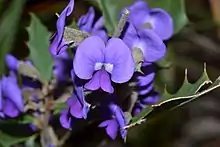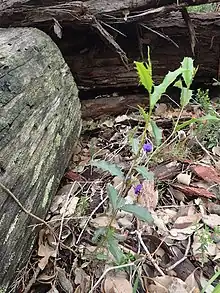| Holly-leaved hovea | |
|---|---|
 | |
| Scientific classification | |
| Kingdom: | Plantae |
| Clade: | Tracheophytes |
| Clade: | Angiosperms |
| Clade: | Eudicots |
| Clade: | Rosids |
| Order: | Fabales |
| Family: | Fabaceae |
| Subfamily: | Faboideae |
| Genus: | Hovea |
| Species: | H. chorizemifolia |
| Binomial name | |
| Hovea chorizemifolia | |
| Synonyms[1] | |
|
List
| |

Hovea chorizemifolia, commonly known as the holly-leaved hovea,[2] is a species of flowering plant in the family Fabaceae and is endemic to the south-west of Western Australia. It is a small, upright shrub with prickly, green leaves and blue-purple pea flowers.
Description
Hovea chorizemifolia is an erect, slender and prickly shrub that typically grows to a height of 0.1 to 0.6 metres (0 to 2 ft), and needle-shaped, hairy stems. The leaves are arranged alternately, flat, hairy, 20–80 mm (0.79–3.15 in) long and 4.5–5.5 mm (0.18–0.22 in) wide on a pedicel 4.5–6.5 mm (0.18–0.26 in) long. The calyx is 6–7.2 mm (0.24–0.28 in) long with simple hairs. The purple-blue corolla is 12.5–18.5 mm (0.49–0.73 in) long, with purple or blue markings. The standard petal is 10–17.5 mm (0.39–0.69 in) long and smooth, wings are 9.5–15 mm (0.37–0.59 in) long, and the keel 7–7.5 mm (0.28–0.30 in) long and smooth. Flowering occurs from May to October and the fruit is a round pod.[2][3]
Taxonomy and naming
Hovea chorizemifolia was first formally described by the botanist Augustin Pyramus de Candolle, in 1825 in his Prodromus Systematis Naturalis Regni Vegetabilis.[4][5] The classification of the species has been revised many times including by Robert Sweet in 1827 as Plagiolobium chorizemifolium in Flora Australasica[6] and as Hovea chorozemaefolia by John Lindley in 1832 in Edwards's Botanical Register.[7] The specific epithet (chorizemifolia), derives from Chorizema and the latin, folium, meaning leaf and thus means leaves resembling those of Chorizema.[8][9]
Distribution
It occurs on hills, breakaways and granite outcrops in the South West, Peel and Great Southern regions of Western Australia where it grows in sandy and gravelly lateritic soils[2] and often as part of jarrah forest communities.[3]
References
- 1 2 "Hovea chorizemifolia". Australian Plant Census. Retrieved 28 July 2021.
- 1 2 3 "Hovea chorizemifolia". FloraBase. Western Australian Government Department of Biodiversity, Conservation and Attractions.
- 1 2 "Plant of the Month - July" (PDF). Blackwood Basin Group. Retrieved 25 October 2018.
- ↑ "Hovea chorizemifolia". APNI. Retrieved 19 May 2022.
- ↑ de Candolle, Augustin P. (1825). Prodromus systematis naturalis regni vegetabilis, sive, Enumeratio contracta ordinum generum specierumque plantarum huc usque cognitarium, juxta methodi naturalis, normas digesta. Vol. 2. Paris. p. 116. Retrieved 19 May 2022.
- ↑ "Plagiolobium chorizemifolium". APNI. Retrieved 19 May 2022.
- ↑ "Hovea chorozemaefolia". APNI. Retrieved 19 May 2022.
- ↑ Sharr, Francis Aubi; George, Alex (2019). Western Australian Plant Names and Their Meanings (3rd ed.). Kardinya, WA: Four Gables Press. p. 162. ISBN 9780958034180.
- ↑ Plant Illustrations: Hovea chorizemifolia. Retrieved 24 October 2018.